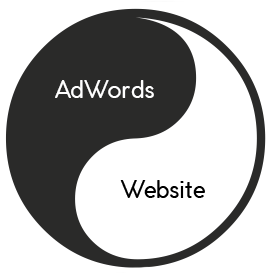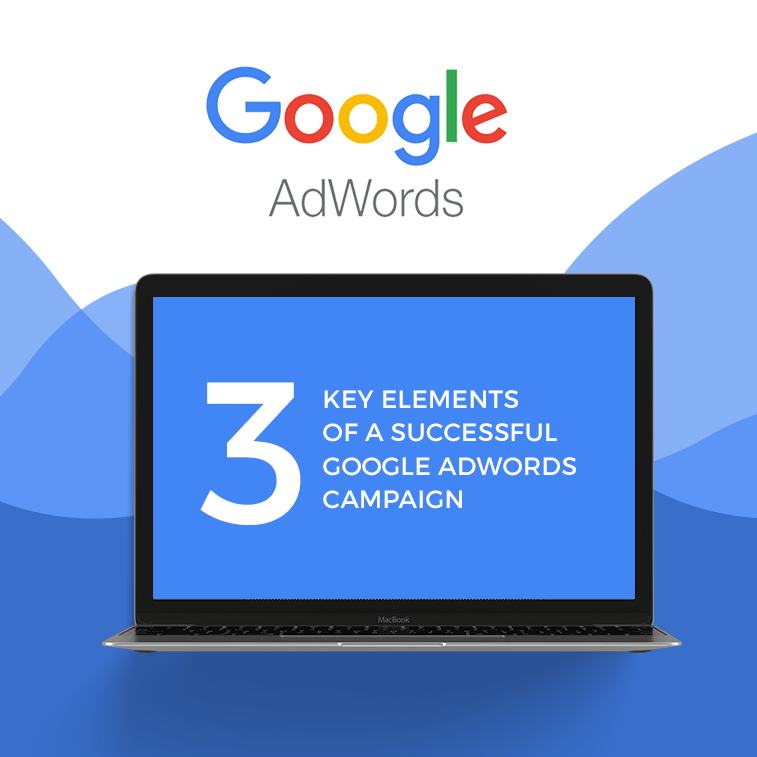If your Google AdWords campaign is failing to deliver ROI you expected, it is almost certainly because one of these three things have gone wrong.
In order for AdWords to work the other pieces of the puzzle also need to be working. The job of AdWords is to bring good quality visitors to your website but AdWords will not close the sale for you. The closing of the sale or lead is the job of your website. Look at AdWords as your Yin and your website as your Yang. If either of the two isn’t doing its job you will fail to make sales. It’s not just AdWords’ fault or just website fault. It could be either or. It could be both. Before you can name a culprit of your poor performance you need to examine carefully both your website and your AdWords.

How to Evaluate your AdWords for Performance Issues
First step is to understand what your AdWords goals and KPIs are (key performance indicators).
AdWords (Yin) has 2 roles:
1. Bring QUALITY traffic to your website. This means that all the visitors you are paying for (all clicks you buy) are the people who are very interested in your products or services. Buying clicks from people who aren’t interested will only result in unwanted expenditure with few or no sales.
2. Bring highest possible QUANTITY of these quality visitors to your website. The more prospects visit your site, the more sales you’ll make. Simple math. Say you have $100-day budget. Advertiser1 will get 50 clicks for their $100 budget, while advertiser2, in the same industry, will buy 100 clicks for their $100 budget. Which one will make more sales with higher ROI? Which one will complain how his AdWords isn’t working?
So the second step in assessing your AdWords performance is working out if you are advertiser1 or advertiser2.
Your Website (Yang) has one job:
1. Persuade visitors that came through Google AdWords to buy your product, make an inquiry, book their stay, contact you for a consult or whatever your end goal is.
It’s like Tinder. You can write whatever catchy description you want and put an amazing photo to get a date but this will only get you as far as the first date. If you disappoint them on the date or don’t meet their expectations for whatever reason, you won’t get a second date.
Your website has the same role. AdWords brought the visitor to the table but your website needs to impress them and persuade them to buy.
How To Assess Your Campaign and Discover Which Areas Need To Get Fixed?
Now that you know which key elements are affecting your outcomes, let’s see how you can evaluate them to see which one is at fault and needing repair.
ELEMENT #1 – Assessing QUALITY of AdWords traffic
Are all search queries shown relevant to your business? What percentage isn’t? This is the % of wasted investment. To assess this you need to look at the Search Terms Report. This report is found under the keywords tab. Don’t look at Keyword report, this is not indicative of the quality of traffic. You don’t care which keywords triggered your ads, you care about what people who came to your site actually searched for (search terms)
Are people bouncing off your site? High bounce rate would indicate that people aren’t finding what they were looking for on your website. Bounce rate is the percentage of people who bounced off after viewing just one page of your site. For simple purchases like trade services, this might not be a bad thing. It could indicate people visiting, calling you to get a quote and then leaving. That’s fine. With more complex purchases where people aren’t likely to buy after seeing just the one page, this is an indicator that they didn’t find what they needed either because 1) your website doesn’t have enough information, isn’t persuasive enough or is dated (website’s fault), or 2) perhaps they weren’t really a good quality lead (AdWords’ fault).
ELEMENT #2 – Assessing QUANTITY of traffic
Are you overpaying for clicks? Overpaying for clicks will reduce the quantity of clicks that your budget can buy. To asses this, look at the quality scores of your keywords. What is your avg score? If it’s <7 then you are paying too much for clicks. You need to improve the quality of your AdWords campaign to get this >7 at a minimum and as close to 10 as possible.
Don’t look at just your CPC in isolation. It could seem too low or too high but this doesn’t mean anything. You can’t change the costs of clicks in your industry. All you can do is ensure you are paying as low CPC as possible. Even if it seems low, still check your QS is >7. If not, then you are overpaying. More importantly, your budget is buying you less clicks than what it could, potentially, be buying you. Improving your QS can bring CPC down even lower resulting in even more visitors, for the same budget.
Is your budget too low? If you are on a very small budget then you might not be getting sufficient volumes of traffic to make any significant/noticeable improvements to your sales. If you are only getting few clicks a day then this is too low to really see much movement in sales. You need to increase your budget (assuming this isn’t low because you are paying astronomical CPCs due to low QS).
Is there enough demand in the marketplace for your products? An increasing budget won’t bring extra clicks when there isn’t enough demand in the marketplace. Low demand could be due to nichness of the product or simply too small serviced locations. This is the toughest one to repair. It’s hard if not impossible to generate demand via AdWords when there isn’t any. Reason being that AdWords (even organic Google search) is a self-initiating platform requiring people to be interested and know of the product in order to search for it.
ELEMENT #3 – Assessing persuasiveness of your website
Are people buying, enquiring or taking action you want them to take? This one is the toughest element to assess. Reason being that there is so many factors that could be preventing people to contact you, enquire, buy etc. It’s also very tough for business owners to objectively assess their websites due to personal involvement and inability to objectively think like a customer (not a business owner).
Here are just a few of the common reasons website fail to persuade visitors to take action:
- outdated design: gives people impression that you might be unprofessional, not trustworthy
- no calls to action: if you don’t tell people to call you or contact you they are less likely to do so
- website too slow to load: impatient visitors will just give up
- hard to find contact information
- no pricing: in some industries where pricing is generally fixed, not having it displayed on a site might give people impression that you are too expensive. Alternatively, people might just be lazy to shop when they can’t see prices
- not enough details about the product/service
- not enough photos (or lack of attractive photos) for visual products
- too much information making it hard to read and understand
- too much technical terms/jargon making it hard for someone outside of the industry to understand
- complex shopping cart & checkout processes
- other barriers to purchase such as: limited payment methods, no guarantees, no postage or shipping costs displayed.
As I mentioned, there are so many website elements that could impact the conversion rates of your website. If you suspect your website might be the problem then get it evaluated by a professional.
Because some advertisers pay more for each click than others. Their cost-per-click (CPC) is higher. Why? Google rewards high-quality good campaigns with the reduced CPC. Google also punishes lower quality campaigns with higher CPC costs. So one plumber can pay $2 per click while his competitor pays only $4. The difference in cost is determined by the quality of their campaign.
So, to ensure you are getting the highest possible QUANTITY of visitors you need to check that the CPC you are paying is the lowest possible. How do you know what’s the lowest possible CPC for your industry? You don’t. There is no benchmark. But, since CPC depends on the quality of your campaign, then the thing to check for is the quality of your campaign. There is a metric called Quality Score. Each keyword in your campaign is assigned a score. The higher your score the lower your CPC. Even if it seems like your click is very expensive, that is only relative. If your QS is highest i.e. QS10 then you can rest assured that your cost-per-click are at your industry’ minimum. Some industries are more expensive to advertise in than others. Insurance, finance, web hosting all demand CPC of >$10. Other industries with lower margins demand CPC <$1. Some advertisers in insurance pay $10 per click while others, with lower quality campaigns, pay $30 for that same click.





